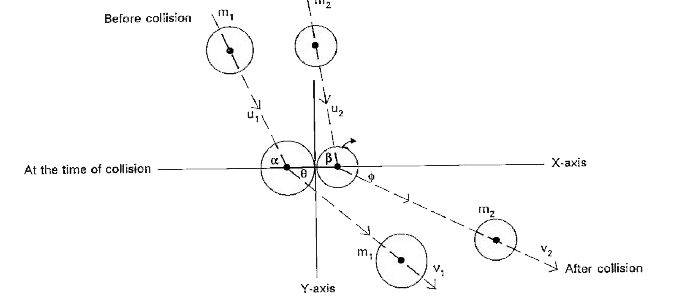Show that two equal masses undergo oblique elastic collision will move at right angles after collision , if the second body initialyy at rest . Solution in Telugu
Oblique elastic collision : If the centres of mass of the colliding bodies are not initially moving along the line of impact, then the impact is called oblique collision
Two equal masses undergo oblique elastic will move at right angles after collosion,if the second body initially at rest :

Consider two smooth and perfectly elastic spheres of masses m1andm2. Let u1andu2 be their initial velocities before collision . Let v1andv2 be their final velocities after collision . (α,β)and(θ,ϕ) are the angles, the directions of motion make with the line of impact before collision and after collision
Since the spheres are smooth, there is no (impulse) change of velocities perpendicular to the time of impact. Hence the resolved part of velocity of the two spheres int he direction perpendicular to the line of impact remain unchanged
∴v1sinθ=u1sinα....(1)
and v2sinϕ=u2β...(2)
According to the principle of conservation of momentum, the sum of the moment of the two spheres along the line of impact before collision and after collision are equal .
∴m1u1cosα+m2u2cosβ=m1v1cosθ+m2v2cosϕ...(3)
→m1(u1cosα−v1cosθ)=m2(v2cosϕ−u2cosβ)....(4)
According to the principle of conservation of kinetic energy, the sum of the K.E along the lien of impact before and after are equal
∴12m1(u1cosα)2+12m2(u2cosβ)2=12m1(v1cosθ)2+12m2(v2cosϕ)2
m1[(u1cosα)2−(v1cosθ)2]=m2[(v2cosϕ)2−(u2cosβ)2]...(5)
(5)(4)⇒u1cosα+v1cosθ=(v2cosϕ+v2cosβ)
v1cosθ=v2cosϕ+u2cosβ−u1cosα....(6)
and v2cosϕ=v1cosθ+u1cosα−u2cosβ....(7)
sub. equation (6) in equation (3) , we get
v1cosθ=(m2−m1m1+m2)u1cosα+2(m2u2m1+m2)cosβ....(8)
and v2cosϕ=(m2−m1m1+m2)u2cosβ+(2m1u1m1=m2)cosα...(9)
If u2=0andm1=m2 then equation (2) we get ϕ=0 and from equation (8),θ=90∘ . This means that if a sphere of mass .m. collides obliquely on another perfectly elastic sphere of the same mass at rest the directions of motions of the spheres after impact will be at right angles
Similar Questions
Prove that in case of oblique elastic collision of two particles of equal mass if one is at rest, the recoiling particles always move off at right angles to each other.
View SolutionTwo bodies of equal masses moving mutually at right angles to each other, collide elastically. After the collision, the particles will move in
View SolutionWhen two spheres of equal masses undergo glancing elastic collision with one of them at rest after collision they will move
View SolutionTwo balls each of mass 2kg (one at rest) undergo oblique collision is perfectly elastic, then the angle between their velocities after collision is
View SolutionProve that in case of oblique elastic collision of two particles of equal mass if one is at rest, the recoiling particles always move off at right angles to each other
View SolutionTwo bodies of equal masses moving mutually at right angles to each other, collide elastically. After the collision, the particles will move in
View SolutionShow that in two demensional elastic I collision between two bodies of equal mass and one body initialy at rest, they move at an angle of frac(pi)(2) after collision.
View SolutionTwo balls of equal masses m each undergo oblique collision. If colision is perfectly elastic, then angle between their velocities after collision is
View Solution

